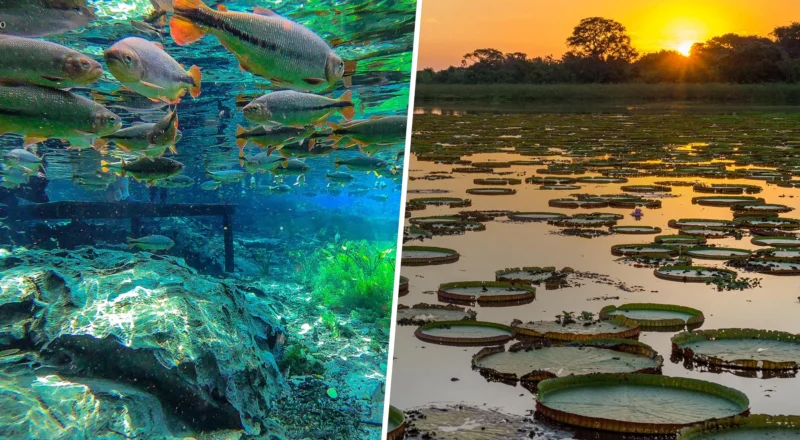If you think Brazil is all about the sun-drenched beaches of Rio and the thundering spectacle of Iguazu Falls, you’re only scratching the surface. Deep in the heart of South America lies a world of pure, untouched nature, a place where the wild is truly wild and the rivers are as clear as glass. I’m talking about the Pantanal and Bonito, two ecotourism gems that offer an adventure unlike any other.
Pantanal and Bonito: A Guide to the Best Ecotourism in Brazil
Imagine yourself on a horseback safari, riding through a landscape teeming with caimans and capybaras. Or perhaps you’d rather drift silently down a crystal-clear river, surrounded by thousands of shimmering fish. These are not scenes from a movie; they are real-life experiences waiting for you.
This guide will take you on a journey through these two incredible destinations, helping you understand their unique magic and how to combine them for the ultimate Brazilian ecotourism trip. Get ready to discover a side of Brazil you’ve never seen before.
The Pantanal: South America’s Wildlife Epicenter
The Pantanal isn’t a national park; it’s the largest tropical wetland in the world, a vast, seasonally flooded savanna and forest that spans an area larger than Portugal. Often called “South America’s Serengeti,” this is the best place on the continent for wildlife viewing. Unlike the dense foliage of the Amazon, the Pantanal’s open landscape makes spotting animals a much more common and rewarding experience.
Visiting the Pantanal is about immersing yourself in nature’s raw beauty and rhythm. Life here revolves around the seasons, which dramatically change the landscape and the types of wildlife you’ll see.
The Seasons: When to Go and What to Expect
Understanding the Pantanal’s two main seasons is key to planning your trip.
- The Dry Season (May to October): This is the prime time for wildlife spotting. As the water recedes, animals are concentrated around the remaining lagoons and riverbanks, making them easier to find. This is also the best time for activities like horseback riding and safaris by jeep, as the land is more accessible. If you’re hoping to see a jaguar—the king of the Pantanal—this is your best chance. The dry conditions force them to the riverbanks to hunt, and boat safaris are designed specifically to track these elusive big cats.
- The Wet Season (November to April): The landscape transforms completely as the rains begin. The plains flood, turning the Pantanal into a vast inland sea. This is the best time for boat tours and canoeing, as the waterways expand and give you access to areas that are otherwise unreachable. The lush greenery is breathtaking, and the birdwatching is spectacular. While it might be harder to see some mammals, you’ll witness a vibrant, aquatic ecosystem thriving.
Image Suggestion: A wide-angle shot of the Pantanal during the dry season, showing a vast, open landscape with a single, winding river, and a group of capybaras and caimans gathered on the banks. The sky should be a clear, deep blue.
Life on a Fazenda: Your Base for Adventure
Most visits to the Pantanal are based out of a fazenda (ranch or lodge), which serves as your home base for exploration. These ranches are not just hotels; they are integral to the ecosystem and the local culture. You’ll eat meals with your guides and fellow travelers, and you’ll experience the hospitality and traditions of the pantaneiros—the cowboys of the Pantanal.
- Daily Rhythm: Your days in the Pantanal are a series of guided activities designed to maximize wildlife encounters. A typical day might start before sunrise with a canoe trip to see the
nascer do sol(sunrise) and spot nocturnal animals returning to their dens. The afternoon could involve a safari by jeep or a horseback ride, and after dinner, you might embark on a night safari to see the jungle’s nocturnal predators, fromcorujas(owls) to raccoons and possibly even an anaconda. - Jaguar Safaris: For many, the ultimate goal is a jaguar sighting. These special tours usually take place in the Northern Pantanal, particularly in the Porto Jofre area, where boat safaris on the Cuiabá River are the most effective way to track them. It’s an unforgettable experience, seeing these magnificent creatures in their natural habitat.
Local Insight: A pantaneiro‘s knowledge of the land is unparalleled. Listen closely to your guides; they can spot a tiny caiman from a mile away or identify a bird by its call alone. Their respect for the land is what makes the Pantanal so special.
Bonito: The Ecotourism Capital of Brazil
Just a few hours south of the Pantanal, you’ll find Bonito, a town that lives up to its name, which means “beautiful” in Portuguese. But the beauty isn’t in the town itself; it’s in the incredible natural attractions that surround it. This is a place defined by its pristine, clear rivers, stunning caves, and a commitment to sustainable tourism.
Bonito operates on a voucher system where all tours must be booked through an accredited agency. This regulated system ensures that the number of visitors at each attraction is carefully controlled, preserving the delicate ecosystems for future generations.
The Rivers: Snorkeling in a Natural Aquarium
The main draw of Bonito is its remarkably clear rivers, which are fed by limestone springs. The water acts as a natural filter, making the rivers so transparent that you can see all the way to the bottom.
Flutuação(Snorkeling): This is the signature activity of Bonito. You’ll don a wetsuit and snorkel gear and simply float down a gentle river current, surrounded by schools of fish in a kaleidoscope of colors. The most famous rivers for this are the Rio da Prata and Rio Sucuri, both offering an otherworldly experience. It’s a peaceful, mesmerizing activity that’s suitable for all ages.
Image Suggestion: An authentic, underwater shot of a person snorkeling in the clear, turquoise waters of a Bonito river. The image should show the sunlight filtering through the water, with dozens of colorful fish swimming calmly around them.
Exploring Underground Worlds
Bonito’s landscape is also marked by a fascinating underground world of caves and grottos.
Gruta do Lago Azul(Blue Lake Grotto): This is Bonito’s most famous landmark, a stunning cave with a deep, blue lake at its bottom. The tour involves a descent down a long staircase to a viewing platform, where you can marvel at the lake’s color, which is a result of sunlight reflecting off the minerals in the water. Swimming is not allowed, but the sight itself is unforgettable.Abismo Anhumas(Anhumas Abyss): For the true adventurers, this is the ultimate Bonito experience. You rappel 72 meters down into a massive cave that holds an underground lake with incredible underwater formations. You can then snorkel or scuba dive in the lake, exploring the incredible stalactites and stalagmites. This tour requires advance booking and a short training session.
Adrenaline and Adventure
If floating and grottoes aren’t enough, Bonito also offers a range of adrenaline-pumping activities.
- Rapids and
Cascadas(Waterfalls): The Rio Formoso offers boat tours and rafting trips for those who want a bit more excitement. For a hike and a chance to swim in beautiful waterfalls, theBoca da Onçatrail is an incredible option, though it is one of the more challenging tours. - Birdwatching: Just like in the Pantanal, Bonito is a great place for birdwatching. The
Buraco das Araras(Macaws’ Hole) is a giant natural sinkhole where hundreds of macaws live, offering a stunning spectacle as they fly in and out.
Image Suggestion: A panoramic view from the Buraco das Araras, showing a vast, green sinkhole with dozens of colorful macaws flying around. The image should capture the scale of the landscape and the vibrant birds.
The Perfect Combo: Logistics and Planning
So, how do you combine these two incredible destinations into one seamless trip? It’s easier than you think, as they are located relatively close to each other in the state of Mato Grosso do Sul.
How to Get There and Around
- Airports: The main gateway for both destinations is Campo Grande (CGR), the state capital. You can fly directly into Bonito (
Bonito) airport (BYO) from a few major Brazilian cities, but flights are less frequent and can be more expensive. For the Pantanal, you’ll need to arrange transportation from Campo Grande to your specificfazenda, which can be a drive of several hours. - Getting Between Them: The distance between Bonito and the Southern Pantanal is manageable, and many tour operators offer private transfers. A taxi or hired car can make the journey in a few hours, allowing you to easily combine the two.
A Typical Itinerary
A popular and effective way to see both is to dedicate about 6 to 8 days. You could spend 3-4 days in Bonito, enjoying the snorkeling, caves, and waterfalls, and then move on to a Pantanal fazenda for 3-4 days of safaris and wildlife observation.
Essential Packing List
The eco-adventure traveler’s packing list for this region is unique:
- Long-sleeved shirts and pants: Essential for sun and mosquito protection, especially in the evening.
- Mosquito repellent: A must-have, especially during the wetter months.
- Comfortable closed-toe shoes: For hiking and horseback riding.
- Waterproof bag: For protecting your camera and phone during water activities.
- Sunscreen and a hat: The sun is intense in this region.
- Swimsuit: For all the amazing water activities.
The Local Difference: Responsible Tourism
What makes Bonito and the Pantanal so special is their shared commitment to responsible tourism. The tours and fazendas are run by passionate locals who live and breathe conservation. They teach you not just about the animals and plants, but also about the importance of preserving this unique part of the world. It’s a trip that not only entertains but also educates and inspires.
So, are you ready to trade the urban jungle for the real thing? The Pantanal and Bonito are waiting, ready to show you the untamed heart of Brazil.
Save this guide for your trip, and share it with a friend who is dreaming of a real-life wildlife adventure!



